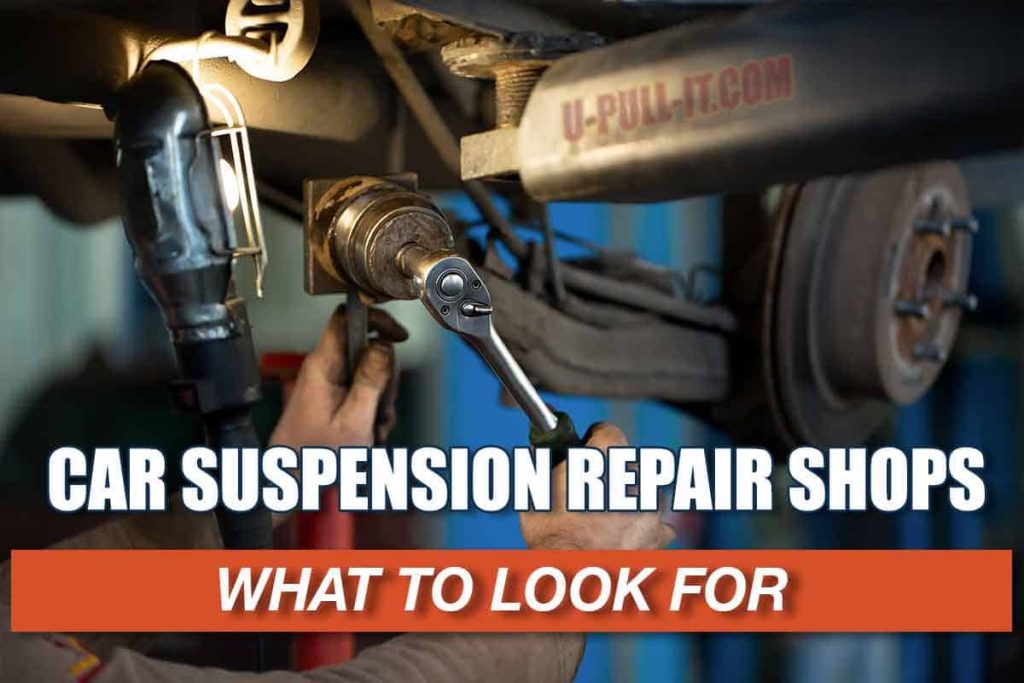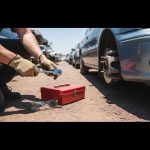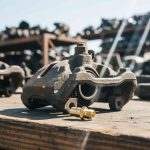Selecting the appropriate car suspension repair shop for your vehicle’s suspension repair, including shock absorber and sway bar, requires thoughtful consideration. One must pay attention to an automotive specialist shop’s reputation and customer reviews, as these can provide invaluable insights into their service quality, particularly during vehicle inspections.
The mechanics’ expertise and automotive specialist certifications are also crucial; after all, one would want their vehicles, specifically car suspension system and steering box, to be handled by proficient professionals. Lastly, it is essential to inquire about the quality of the automotive parts used for car suspension system repairs, including the rear suspension and rubber components.
Utilizing subpar components in your car suspension system could lead to frequent automotive breakdowns and costly re-repairs, especially in the rear suspension and cabin. Therefore, ensuring an automotive repair shop uses high-quality parts, particularly in the car suspension system and rear suspension, is non-negotiable for long-lasting performance and cabin safety on the road.

Car Suspension Basics
The Role of Suspension Systems
Car suspension systems are crucial. They ensure a smooth ride.
Suspension systems connect the car to its wheels. They absorb bumps and shocks from the road.
For example, when you drive your cabin vehicle over a pothole, your suspension system takes the hit, not you or your average repair cost.
Importance of Healthy Suspensions
A healthy suspension system is vital for safety. It helps maintain control while driving.
If your cabin car’s suspension is faulty, it may sway or slide during turns, potentially increasing the average repair cost. This can lead to accidents.
According to a report by the National Highway Traffic Safety Administration (NHTSA), poor vehicle maintenance, including neglecting suspensions, contributed to about 45% of accidents in 2019, escalating the average repair cost.
Common Suspension Issues
Several problems can affect car suspensions. These include worn-out shock absorbers and loose bearings.
Steering and Suspension Repair
Car suspension repair is crucial. It’s tied to steering, affecting vehicle control.
Interconnectedness of Steering and Suspension
Steering and suspension systems are united. They’re like two peas in a pod.
For instance, your car’s tie rods connect the two. The tie rod ends, a crucial part of the car suspension system, link to the wheels, dictating their movement. Suspension repair costs can be impacted by these components. If these parts break, both systems suffer.
Common Steering and Suspension Issues
Several issues can plague these systems. Some common problems include:
- Faulty steering box: This affects steering response.
- Damaged rear suspension: It hampers handling.
- Worn-out sway bar: Your car may lean more in turns.
These issues need immediate attention from an automotive specialist.
Impact on Vehicle Control
When compromised, these systems affect vehicle control. For example, a faulty steering box makes it harder to steer your car.
What to Look for in a Car Suspension Repair Shop
Finding a Reputable Repair Shop
Use online reviews and recommendations from friends when looking for a reliable car suspension system. Also, check for affiliations with industry organizations like the AAA or ASE.
- Online Reviews: Check Google, Yelp, and other platforms.
- Recommendations: Word of mouth still matters.
- Affiliations: Look for ASE or AAA certifications.
Questions to Ask Before Repair
Before you commit to a car suspension system, make sure to ask the following questions.
- What is the estimated cost?
- How long will the repair take?
- Do you offer a warranty?
Understanding the Estimate
A good estimate should include labor costs, parts, and any additional fees. Make sure everything is itemized and ask for clarification if needed.
Cost of Suspension Repair
The cost can vary widely depending on the issue and the make and model of your car. Generally, you can expect to pay between $200 and $2,000.
Red Flags to Avoid
Be wary of shops that:
- Offer extremely low estimates
- Don’t provide written estimates
- Have poor customer reviews
Customer Reviews and Testimonials
While online reviews are helpful, also consider testimonials from people you know. Personal experiences can offer invaluable insights.
Warranties and Guarantees
Always ask about the warranty on both parts and labor. A reputable shop will stand behind their work.
Major Parts of the Car’s Suspension System
The car suspension system is made up of several different parts. Each part plays an important role in making your rides smooth.
- Springs: These absorb road shocks.
- Shock Absorbers: They control spring movements.
- Struts: These are a structural part of the suspension system.
- Tires and Air: Tires, filled with air, also form a part of the suspension.
Role of Each Component
Each component has its own job. Together, they ensure optimal handling performance.
- Springs compress and expand to absorb shock.
- Shock absorbers dampen the bouncing caused by springs.
- Struts provide support to the vehicle’s weight.
- Tires and air cushion between the car and road.
Ball Joint Replacement
Role of Ball Joints
Ball joints are crucial in your car’s suspension system. They connect the control arms to the steering knuckles, bearing your vehicle’s weight.
These joints allow for smooth rotation and movement. When they’re working well, you enjoy a comfortable ride.
Symptoms Indicating Need for Replacement
But how do you know if your ball joints need replacement? There are signs to watch out for.
Your car may start making strange noises. You might hear clunking sounds when going over bumps or turning corners.
Another sign is uneven tire wear. If one side of your tires wears out faster than the other, it could be due to bad ball joints.
The last symptom is difficulty steering. If your car veers to one side while driving, it might mean that the ball joints are worn out.
Coil Spring Service
Coil springs are vital for a smooth ride. Ignoring their issues can lead to risks.
The Role of Coil Springs
Coil springs absorb road shocks. They make your journey comfortable.
For example, when you drive over a bump, the springs compress. They absorb the shock so you don’t feel it as much.
Signs You Need Spring Services
Your car might need spring service if it’s not driving smoothly. Another sign is if one corner of your car sits lower than the others.
Here are some more signs:
- Your car leans or sways when turning.
- There’s a clunking noise when going over bumps.
- The ride feels bouncy or rough.
Risks of Ignoring Spring Issues
Ignoring spring issues can be dangerous. It can affect your car’s balance and control.
If your springs break while driving, it could cause an accident.

Shocks & Struts Replacement
Functionality of Shocks and Struts
Shocks and struts are key parts in a car’s suspension system. They absorb road impact, making rides smoother.
Shock absorbers, or shocks, are located near the wheels. Their job is to reduce bounces when driving.
Struts combine shock absorbers and coil springs in one unit. They provide structure for the shock towers.
When to Replace Shocks or Struts
It’s important to know when your shocks or struts need replacement. Here are some signs:
- Your car bounces excessively after going over a bump.
- You notice leaks around the shock or strut body.
- The tires wear out unevenly due to the car leaning more on one side.
- There’s rust on mounts, bolts, and bushings.
These indicators suggest that your shocks or struts require attention.
What’s the Difference Between Shocks and Struts
Structural Differences
Shocks and struts are not the same. They have different structures.
- Shocks, short for shock absorbers, are independent components of your car’s suspension system.
- Struts, on the other hand, are a structural part of the suspension system. They integrate numerous suspension parts into one compact assembly.
Unique Roles in Suspension System
Both shocks and struts have unique roles in your car’s suspension system.
- Shocks help control the movement of your vehicle’s springs and suspension. They keep your tires grounded for a smooth ride.
- Struts also dampen spring oscillations like shocks. But they provide structural support for your vehicle’s suspension system too.
Performance Impact on Driving Experience
The performance of shocks and struts affects how you experience driving in distinct ways.
Signs Your Car Needs Suspension Repair
Your car might need a suspension repair. Look out for these signs.
Noises From Undercarriage
While driving, listen carefully. If you hear strange noises coming from under the car, this could be a warning sign. These sounds may include squeaks, clunks or rattles.
- Squeaks: Usually indicate worn-out or broken suspension bushings.
- Clunks: May suggest problems with shock absorbers or struts.
- Rattles: Could point to loose bolts in the suspension system.
Conducting a Bounce Test
What is a Bounce Test
A bounce test is simple. It’s a way to check your car’s suspension.
How to Perform it
To perform this test, push down on your car’s rear end. If it bounces more than twice, pay attention. This could be a sign of trouble with the suspension.
- Park your car on a flat surface.
- Stand at the rear of your vehicle.
- Use both hands to push down on the car.
- Notice how many times it bounces.
If you see excessive bouncing, it’s time for a check-up.
Importance of Bounce Test
The bounce test helps identify issues early. It can save you from costly repairs in the future.
Your Car Nose Dives When You Hit a Bump
The Nose-Dive Phenomenon
Your car nose-diving when hitting a bump signals worn-out shocks or struts. This occurrence is not only uncomfortable, but it also poses safety risks.
Safety Risks of Nose-Diving
When your car’s suspension system isn’t functioning correctly, it can result in nose-diving. This behavior can lead to:
- Reduced steering and braking control.
- Increased risk of accidents due to unsteady vehicle movement.
Importance of Immediate Repair
Ignoring these signs can cause further damage to your car. It’s crucial to take your vehicle to a trustworthy car suspension repair shop immediately when you notice this problem.
What To Look For In A Car Suspension Repair Shop
When choosing a repair shop for your car suspension problems, consider the following:
Your Car Produces Clunking Noises When in Motion
Suspension problems often announce their presence through strange noises. Ignoring these sounds could lead to severe issues.
Causes of Clunking Noises
Your car’s suspension system is complex. It includes many parts that can make clunking noises when they start to fail. These may include:
- Worn out struts or shock absorbers
- Damaged control arms
- Broken springs
These components are crucial for a smooth ride and safe handling.
Consequences of Ignoring the Sounds
Ignoring these noises is not a good idea. If left unchecked, the problem can worsen over time, leading to:
- Uncomfortable rides due to increased vibrations
- Poor handling and potential accidents
- More expensive repairs down the line
It’s always better to address these issues early.
Your Steering Wheel Is Vibrating or Shaking
Reasons Behind Steering Wheel Vibrations
Steering wheel vibrations can be scary. They might indicate a problem with your car’s suspension system.
Connection Between Shaking Steering Wheel and Suspension Issues
A vibrating steering wheel often signals suspension issues. If your wheels aren’t balanced, the ride becomes shaky.
- For instance, if your tires are worn unevenly, they can cause the steering wheel to vibrate.
- Another scenario is when the shock absorbers are faulty. This can also lead to a shaking steering wheel.
Risks of Driving With a Vibrating Steering Wheel
Ignoring a vibrating steering wheel is risky. It could lead to serious accidents.
- A shaky ride reduces control over the vehicle.
- The car may veer off unexpectedly due to unbalanced wheels.
Your Car Pulls to One Side
Car pulling is a common problem that many drivers face. It’s often linked to alignment or suspension issues in your vehicle.
Why Car Pulling Happens
When you’re driving, you might notice your car pulls to one side. This isn’t normal. It usually means there’s a problem with your car’s alignment or suspension.
For example, if the front and rear tires are not aligned properly, it can cause the car to pull. The same thing can happen if there’s an issue with the suspension system.
Dangers of Ignoring Car Pulling
Ignoring this symptom is dangerous. When a car pulls to one side, it affects your control over the vehicle. You may struggle to keep the car straight on the road.
This can be especially risky when braking or turning corners. If your car pulls during these actions, it could lead to an accident.
You Notice Excessive or Uneven Tire Wear
The state of your tires can tell you a lot about your car’s suspension. If they’re wearing unevenly, it could be a sign of suspension trouble.
Correlation Between Uneven Tire Wear and Suspension Issues
Uneven tire wear is often linked to suspension problems. When the suspension isn’t working properly, it puts undue stress on certain parts of the tire.
- The inside may wear out while the outside stays new.
- Or, the front tires could wear down faster than the rear ones.
This isn’t normal. It’s a sign that something’s wrong with your car’s suspension.
How Improper Alignment Leads to Uneven Tire Wear
Improper alignment is another common cause of uneven tire wear. It happens when the wheels aren’t lined up correctly with each other and the road.
You Spot Visible Signs of Damage
Car suspension problems often show visible signs. Regular inspections can help spot these early.
Types of Visible Damages
Car suspensions might show various types of damage. For instance, you could notice fluid leaks or dented shock absorbers. These are clear signs that your car’s suspension system needs attention.
- Fluid leaks: If you see oil or fluid under your car, it could indicate a leak in the shock absorbers.
- Dents: Shock absorbers and struts should be straight and free from dents. Any physical damage can affect their performance.
Importance of Regular Visual Inspections
Regular visual checks play a crucial role in maintaining your car’s health. It helps identify potential problems before they worsen, saving time and money in the long run.
- Safety: Regular inspections ensure safety by detecting issues early.
Maintenance Tips for Car Suspension
Regular Checks and Preventative Measures
Regular maintenance is key to a long-lasting car suspension. It’s like taking vitamins to stay healthy.
- Check your car’s suspension system often.
- Look for signs of wear and tear.
- Fix small issues before they become big problems.
This will help ensure a smooth ride every time you hit the road.
Proper Tire Inflation and Alignment
Tire care plays an important role in maintaining your suspension. Think of it as the shoes of your car.
- Keep tires properly inflated.
- Regularly check tire alignment.
Doing these simple tasks can prevent unnecessary wear on your suspension system, giving you a smoother, safer drive.
Timely Repairs and Replacements
Don’t ignore issues with your car’s suspension. It’s like ignoring a toothache – it won’t get better on its own!
Car Suspension Repair Costs: What You Should Expect to Pay
Let’s delve into the factors that influence car suspension repair costs. We’ll also discuss the average price range for common repairs.
Cost Influencing Factors
Car suspension repair cost varies. It depends on your car type, damage extent, and mechanic’s labor rate.
- Luxury or high-performance cars typically have more expensive parts.
- More extensive damage means more parts to replace.
- Mechanics in urban areas often charge higher rates than those in rural areas.
Buying Used Car Suspension Parts From a Local Salvage Yard or Junkyard
Purchasing used suspension parts from a reputable junkyard can be an excellent choice for several reasons. First and foremost, most well-established wrecking yards offer a 30 to 90-day warranty on parts, giving you the confidence to invest in used components. This warranty period allows you to test the part thoroughly and offers the option to exchange it if you encounter any defects or fitment issues.
Moreover, reputable junkyards often provide an interchange system, a valuable tool identifying which vehicles have compatible suspension systems. This system simplifies the search process, saving you time and effort. It also increases the likelihood of finding a part that fits perfectly, thereby reducing the risk of compatibility issues.
Buying used suspension parts from a reputable salvage yard is a cost-effective and relatively low-risk option, especially when warranties and interchange systems are in place. While it’s always advisable to consult a knowledgeable mechanic for any car repair, these safeguards make junkyards a viable source for quality used parts that can save you money without compromising performance.
Finding a Reliable Local Car Suspension Repair Shop
Trust Expertise and Service Quality
When choosing a mechanic, trustworthiness is key. You want someone who knows their stuff. Expertise matters too. A professional can spot problems quickly.
Service quality is also important. Good shops won’t leave you in the dark. They’ll explain everything clearly.
Personal Recommendations and Online Reviews
Personal recommendations can be helpful. Friends might know good mechanics. Ask around before making your choice.
Online reviews are another great resource. They give insight into other people’s experiences with shops.
Warranty Offers Matter
Finally, consider warranty offers when choosing a shop for car suspension repairs. Some garages offer warranties on their work, which can provide peace of mind knowing that if something goes wrong after the repair, you won’t be left out of pocket.
Navigating Car Suspension Repair
Understanding the Repair Process
Car suspension problems can be tricky. It’s important to know what’s involved in diagnosing and repairing them.
A good repair shop will first examine your car for visible signs of damage. They’ll look at the shocks, struts, and springs.
Next, they’ll test drive your car. This helps identify any unusual noises or vibrations.
After that, they might use special tools to inspect hard-to-see parts. These could include bushings and control arms.
Wrapping Up Your Car Suspension Repair Journey
To ensure your car’s optimal performance, it’s crucial to keep an eye on its suspension system. Regular inspection and maintenance can help you spot early signs of damage or wear, such as clunking noises, excessive tire wear, or a vibrating steering wheel. If you notice these symptoms, don’t hesitate to seek professional help from a trusted local car suspension repair shop.
Remember, quality service may not always come cheap but paying for competent repairs is an investment in your vehicle’s longevity and safety. So choose wisely and prioritize expertise over cost-cutting. Ready to get started? Find a reliable local car suspension repair shop today and take the first step towards enhancing your driving experience!
FAQS
What are the key components of a car suspension?
The key components of a car suspension include the ball joints, coil springs, shocks & struts. These parts work together to absorb shock from road bumps and maintain stability when turning.
How do I know if my car needs suspension repair?
Signs that your car might need suspension repair include clunking noises when in motion, excessive or uneven tire wear, shaking or vibrating steering wheel and visible signs of damage.
How much should I expect to pay for car suspension repair?
The cost of repairing your car’s suspension can vary widely depending on the extent of damage and where you live. However, be prepared for costs ranging from $200 to $1500 for common repairs like strut replacement.
What’s the difference between shocks and struts?
Shocks are designed primarily to absorb road shock while struts serve as a structural part of the chassis by holding up much of the vehicle’s weight. Both play critical roles in maintaining ride comfort and handling.
How long does it take to repair my car’s suspension?
Minor repairs like replacing a shock absorber can often be completed within a few hours. More complex issues like a complete suspension overhaul could take several days.
What are the signs that my car’s suspension system needs repair?
Some signs that your car needs suspension repair include a bumpy or a not smooth ride, one side of the car sitting lower than the other, difficulties in steering, and noticing that your car’s front suspension is going lower than normal. If you experience such issues, it’s likely that parts of your suspension may need to be replaced.
What does a front suspension repair entail?
A front suspension repair typically involves replacing or repairing various suspension components in the front of your car like the front wheel, linkage, axle, and the arm bushings. Depending on the condition of the front suspension, you may also need a wheel alignment.
How much does it typically cost to repair a damaged suspension?
The cost to repair a damaged suspension can vary depending on the extent of the damage and the vehicle’s make and model. However, you can usually get a free estimate of the cost at an auto repair shop.
Can I continue to drive if my suspension system is damaged?
It is not advisable to continue driving with a damaged suspension as it can lead to more damage to your vehicle’s front and back and may impact your vehicle suspension’s overall functionality. Instead, get your car to a car service near you for immediate repair.
What does a car’s suspension system include?
A car’s suspension system includes several components such as the axle, the front wheel, and arm bushings. This system is responsible for providing a smooth ride by minimizing the impact of bumps in the road.
Is there a way to maintain my car’s suspension system?
Yes, you can maintain your car’s suspension system by regularly checking for signs of wear and tear and ensuring your vehicle receives regular maintenance. If your car seems bumpy or unstable, then that could be a sign your suspension needs check-ups.
How do I know if my car needs a front wheel alignment?
You may need a front wheel alignment if you notice that your car is pulling to one side, the tires are wearing out unevenly, or if your steering wheel is off-centered when driving straight. If these symptoms persist, contact an auto repair shop near you.
When should suspension components be replaced?
Suspension components need to be replaced if they show signs of excess wear or damage, impact the handling of the car or your car’s ability to absorb bumps in the road. It’s always recommended to seek repair services soon as you notice these signs.
How will a proper suspension system contribute to a smooth ride?
A well-functioning suspension system contributes to a smooth ride by absorbing the impact and vibrations caused by bumps and irregularities in the road, ensuring that your car does not lose contact with the road surface.
How long can I expect the repair to take?
The duration of a suspension repair can vary depending on the specific repairs needed. Some issues may be fixed in a few hours while others may require a few days. However, good repair services should have your vehicle back on the road as soon as possible.




